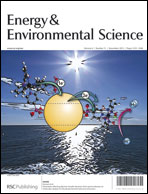Nitrogen-doped graphene for dye-sensitized solar cells and the role of nitrogen states in triiodide reduction†
Abstract
Nitrogen-doped graphene was demonstrated as an efficient and alternative metal-free electrocatalyst for dye-sensitized solar cells. Electrochemical measurements showed that the nitrogen-doping process can remarkably improve the catalytic activity of graphene toward triiodide reduction, lower the charge transfer resistance, and thus enhance the corresponding photovoltaic performance. Furthermore, the nitrogen doping levels ranging from 3.5 at% to 18 at%, as well as the nitrogen states (including pyrrolic, pyridinic and quaternary configurations) in graphene, were controlled to interpret the roles of graphene structure in catalytic activity and device performance. The results suggested that the nitrogen states, rather than the total N content, have a significant effect on the catalytic activity. Both pyridinic and quaternary nitrogen states can provide active sites for promoting triiodide reduction reaction, probably due to the shift in redox potential and the lowered adsorption energy.


 Please wait while we load your content...
Please wait while we load your content...